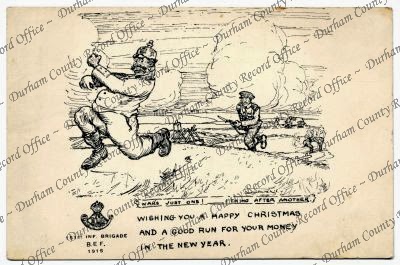 |
| D/DLI 7/238/4(1) Second Lieutenant John Walcote Gamble |
John
Walcote Gamble was a Second Lieutenant in the 14th Battalion, Durham
Light Infantry. In our collections we
have a typescript book of the letters (D/DLI 7/238/4) he wrote, likely to his
mother, from 9 October 1915 to 17 May 1916.
Well educated, his letters are evocative of the ups and down of a
soldier’s life, and are not without a sense of humour.
Xmas
Eve 1915.
It is not the
pleasantest of Xmas Eves, but it might be a lot worse, and we are all sitting
chatting in a dug-out now, and keeping as cheery as
possible.
Everyone is in a fairly good humour, inspite of the wet, the strafing, and the effects of that horrid gas attack, from which we have not all properly recovered.
Yes, most of the Officers are in a good humour - absolutely must be - because one of them, who possesses a fountain-pen, which he guards like a priceless treasure, and which he will rarely allow anyone but himself to use, has offered me the loan of it whilst scribbling this!
The Bosche is not so wicked to-night as he has been recently, and we are taking advantage of it to try and get our Xmas Eve Dinner. We are just waiting for it to appear now, and the cook is working manfully to give us something like a spread.
His greatest difficulty is to keep a fire going, for there is water in the trench (it is raining) and whenever Fritz sees a cloud of smoke he invariably sends a whiz-bang into it.
We are well supplied with good things thanks to you and other friends, and to the other 4 Officers' "yous" and other friends, and don't we just appreciate them? We shall be compelled to eat most things cold, both to-day and to-morrow, but we shall not enjoy them any the less.
The poultry is coming in now, and it does look splendid. (Adjournment for Grub).
The Bosche's quietness rather puzzles us tonight. Whether it means he is trying to be festive and enjoy himself for a little time, or whether he is working up for a "strafe big" to-morrow is the question, but it does not really matter what his idea is, because we are going to give him a little present to put in his stocking in return for the gas he presented us with last Sunday.
Everyone is in a fairly good humour, inspite of the wet, the strafing, and the effects of that horrid gas attack, from which we have not all properly recovered.
Yes, most of the Officers are in a good humour - absolutely must be - because one of them, who possesses a fountain-pen, which he guards like a priceless treasure, and which he will rarely allow anyone but himself to use, has offered me the loan of it whilst scribbling this!
The Bosche is not so wicked to-night as he has been recently, and we are taking advantage of it to try and get our Xmas Eve Dinner. We are just waiting for it to appear now, and the cook is working manfully to give us something like a spread.
His greatest difficulty is to keep a fire going, for there is water in the trench (it is raining) and whenever Fritz sees a cloud of smoke he invariably sends a whiz-bang into it.
We are well supplied with good things thanks to you and other friends, and to the other 4 Officers' "yous" and other friends, and don't we just appreciate them? We shall be compelled to eat most things cold, both to-day and to-morrow, but we shall not enjoy them any the less.
The poultry is coming in now, and it does look splendid. (Adjournment for Grub).
The Bosche's quietness rather puzzles us tonight. Whether it means he is trying to be festive and enjoy himself for a little time, or whether he is working up for a "strafe big" to-morrow is the question, but it does not really matter what his idea is, because we are going to give him a little present to put in his stocking in return for the gas he presented us with last Sunday.





